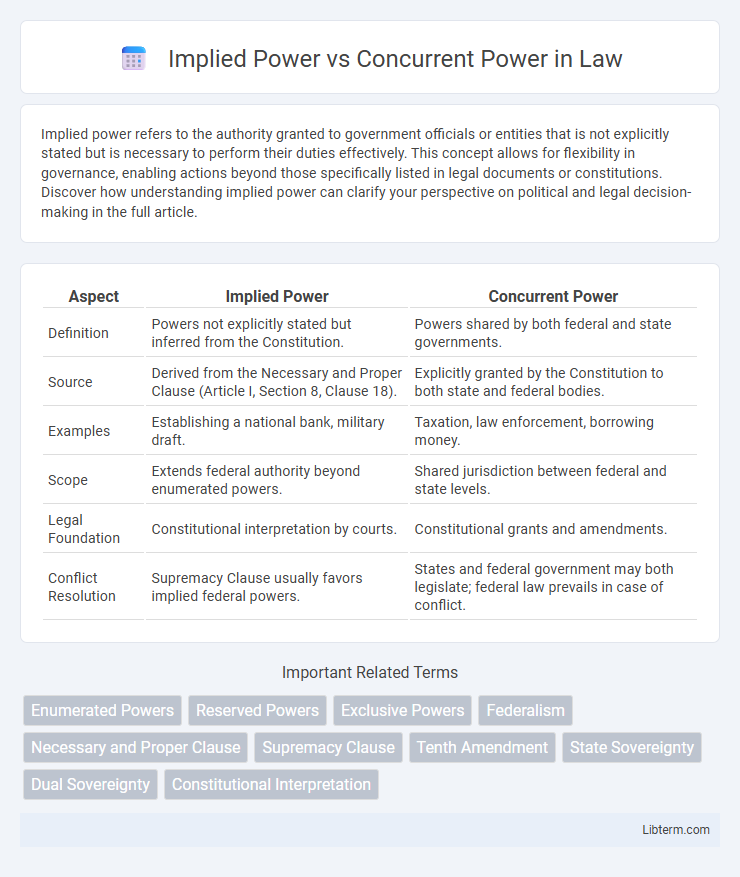Implied power refers to the authority granted to government officials or entities that is not explicitly stated but is necessary to perform their duties effectively. This concept allows for flexibility in governance, enabling actions beyond those specifically listed in legal documents or constitutions. Discover how understanding implied power can clarify your perspective on political and legal decision-making in the full article.
Table of Comparison
| Aspect | Implied Power | Concurrent Power |
|---|---|---|
| Definition | Powers not explicitly stated but inferred from the Constitution. | Powers shared by both federal and state governments. |
| Source | Derived from the Necessary and Proper Clause (Article I, Section 8, Clause 18). | Explicitly granted by the Constitution to both state and federal bodies. |
| Examples | Establishing a national bank, military draft. | Taxation, law enforcement, borrowing money. |
| Scope | Extends federal authority beyond enumerated powers. | Shared jurisdiction between federal and state levels. |
| Legal Foundation | Constitutional interpretation by courts. | Constitutional grants and amendments. |
| Conflict Resolution | Supremacy Clause usually favors implied federal powers. | States and federal government may both legislate; federal law prevails in case of conflict. |
Introduction to Governmental Powers
Implied powers are those not explicitly stated in the Constitution but are necessary for implementing the government's enumerated powers, derived from the Necessary and Proper Clause. Concurrent powers refer to authorities shared by both federal and state governments, such as taxation, law enforcement, and maintaining courts. Understanding the distinction between implied and concurrent powers clarifies the scope and limits of governmental authority within the federal system.
Defining Implied Power
Implied power refers to governmental authority not explicitly stated in the Constitution but inferred from the Necessary and Proper Clause, allowing Congress to pass laws essential for executing its enumerated powers. Concurrent power, on the other hand, describes authority shared by both federal and state governments, such as taxation and law enforcement. Understanding implied powers clarifies how legislative bodies adapt constitutional limitations to address complex governance needs.
Understanding Concurrent Power
Concurrent powers are authority shared by both federal and state governments, allowing them to independently Levy taxes, establish courts, and enforce laws within their jurisdictions. These powers enable a balanced governance system, where state and federal levels collaborate yet operate autonomously in certain areas. Understanding concurrent power highlights the complexity of federalism and the dynamic interplay between different government layers in the United States.
Constitutional Basis of Implied Power
The constitutional basis of implied powers is primarily derived from the Necessary and Proper Clause (Article I, Section 8, Clause 18) of the U.S. Constitution, which grants Congress the authority to make laws required to execute its enumerated powers. Implied powers allow the federal government to take actions not explicitly listed in the Constitution but essential for carrying out its duties effectively. Concurrent powers, in contrast, are shared authority exercised by both federal and state governments, such as taxation and law enforcement, clearly recognized within the constitutional framework.
Constitutional Basis of Concurrent Power
Concurrent powers arise from the U.S. Constitution's federal framework, allowing both state and federal governments to legislate and enforce laws independently within the same domain. These powers, such as taxation and law enforcement, are explicitly or implicitly recognized to enable cooperative governance without conflict. Unlike implied powers derived from the Necessary and Proper Clause, concurrent powers have a direct constitutional basis ensuring state sovereignty alongside federal authority.
Key Differences Between Implied and Concurrent Powers
Implied powers are derived from the Necessary and Proper Clause, enabling the federal government to enact laws essential for executing enumerated powers, while concurrent powers are authorities shared by both federal and state governments, such as taxing and law enforcement. Implied powers expand federal legislative capabilities beyond explicit constitutional text, whereas concurrent powers emphasize cooperative governance and overlapping jurisdiction between state and federal levels. The key difference lies in implied powers being federal-centric and derived through constitutional interpretation, while concurrent powers represent mutual sovereignty exercised simultaneously by multiple government tiers.
Examples of Implied Powers in Practice
Implied powers, derived from the Necessary and Proper Clause of the U.S. Constitution, allow Congress to pass laws essential for executing its enumerated powers, such as establishing a national bank or regulating interstate commerce. Concurrent powers, shared by both federal and state governments, include taxing citizens and enforcing laws independently within their jurisdictions. Examples of implied powers in practice demonstrate federal authority extending beyond explicit constitutional mandates, enabling effective governance and adaptation to emerging issues.
Examples of Concurrent Powers in Practice
Concurrent powers refer to authorities shared by both federal and state governments, such as taxation, law enforcement, and the establishment of courts. For instance, both state and federal governments collect income taxes and maintain separate police forces to uphold laws within their jurisdictions. These overlapping powers allow cooperation and a balance of governance while addressing local and national needs effectively.
Legal Conflicts and Resolutions
Implied powers, derived from the Necessary and Proper Clause, often create legal conflicts with concurrent powers, which are shared by state and federal governments. Courts resolve these disputes by interpreting the Supremacy Clause, consistently upholding federal implied powers when state laws contradict national interests. Landmark cases such as McCulloch v. Maryland and Gibbons v. Ogden illustrate how judicial review balances these powers and clarifies federal supremacy.
The Impact of Implied and Concurrent Powers on Federalism
Implied powers, derived from the Necessary and Proper Clause, enable the federal government to adapt its authority beyond explicitly stated constitutional powers, thereby expanding federal influence and sometimes challenging state sovereignty. Concurrent powers, such as taxation and law enforcement, allow both federal and state governments to exercise authority simultaneously, fostering cooperation but occasionally leading to jurisdictional conflicts. The dynamic tension between implied and concurrent powers shapes the balance of federalism by continuously redefining the scope and interaction of state and federal governments.
Implied Power Infographic

 libterm.com
libterm.com